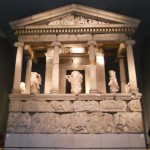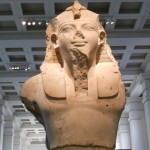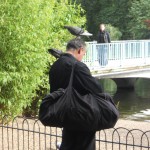Entries Tagged as '2010 Michael'
September 21st, 2010 · 1 Comment
The British Museum. Bang. Zoomph! Woop. Boom! The biggest statues, the coolest marbles, the most languages per stone, a whole bunch of the Parthenon. Beowulf. The museum is like a pirate’s hoard. It is everything awesome that the Brits could find and lug back to their island, displayed in a massive ceiling’d amalgamation of rooms with entirely uncoordinated and impossible to follow numbers that follow no logical pattern. Doesn’t get much better than that. Cleopatra’s body is there! Things that just have no business being there are all just hanging out at the British Museum and it is like it’s no big deal. You wander through the museum, stumbling upon gigantic Egyptian and Greek statues portraying God’s and mythical battles.
This brings me to an interesting point that I am sure has been discussed throughout these blogs ad nauseum. It is this British idea that somehow these priceless objects belong in the British Museum and not, say, back in their respective countries of origin. I’ll refer here to a quote from a plaque in the Greek portion of the museum.
“The Parthenon sculptures in the British Museum were brought to England by Lord Elgin and bought for the Museum in 1816. Elgin’s removal of the sculptures from the ruins of the building has always been a matter of discussion, but one thing is certain- his actions saved them further damage by vandalism, weathering and pollution. It is also thanks to Elgin that generations of visitors have been able to see the sculptures at eye level rather than high up on the building.”
Okay, let’s ignore the last sentence as the Museum is clearly grasping at straws. Obviously, the sculptures could be at eye level in Greece. Instead I’d like to focus on the phrase ‘one thing is certain.’ So that is to say that it isn’t certain that the sculptures should be back in Greece. As if both countries have a legitimate claim to the sculptures and it is a matter of debate, instead of a simple matter of Britain not wanting to give the sculptures back.
The other museum that I found truly blog-worthy is called the Welcomme Collection. It was of interest for a number of reasons. First was simply the content. One of the major exhibits I explored was on medicine, exploring its history. But what really set this museum apart was the way it was presented. The first thing I saw upon walking into the exhibit was a massive plastic model of a person, entirely consumed by bulbous fat. It had no head or features besides legs. And then there was thorough analysis on the side. This wasn’t a museum designed to wow in the way the British Museum did. It was supposed to provoke thought. The exhibit pointed out how humans had evolved in an environment in which we had to walk considerable distances and could not eat very often. And that through technology we eliminated this need to walk while also increasing the availability of calorie-rich foods. And that many developments (such as a remote control, automatic can opener) were designed to remove any sort of exercise from day to day life. But at the same time, humans are inventing products such as stationary bikes to increase artificial exercise. In the next room I came upon three chairs in glass. Two were dentist’s chairs, one from 1900 and the other from before that. The third chair was a torture chair covered in blades and hooks from Ancient China. The plaque on the side did not explain the connection between the three, but it was a shocking exhibit all the same. The final thing of interest about the Welcomme Collection was the clientele. It was mostly young people, teenagers and mid-twenties, and a seemingly alternative culture. Girls with pink Mohawks and black leather jackets, that sort. Another really cool exhibit contained an actual metal chastity belt from centuries ago, which I did not realize existed.
These two museums are particularly interesting when juxtaposed. The British Museum needs no explanation. It’s exhibits are shockingly valuable and famous. The Welcomme Collection provokes thought and puts together interesting and obscure objects.
Tags: 2010 Michael · Museums
September 21st, 2010 · No Comments
In this blog I’ll just give disjointed thoughts about the different places of worship which we have visited and then thoughts on our in class conversations regarding religion. First off, I really loved the Bath Abbey. It was tremendously impressive without the pomp of many of the other places we visited. It was not so heavily touted, there was no security. It was unimposing. It was geared toward humbled devotion to God rather than self-aggrandizing homage to England’s greats, and, therefore, to England itself. Westminster Abbey and St. Paul’s Cathedral are guilty of this fault in my opinion.
The Mandir was another great experience. Marble is one of my favorite materials both for its look and feel. The hand carvings were also astonishing and I liked that we were a part of the ceremony. It was, for me, the most moving of all the religious experiences we had. I think it was especially powerful for me as it provided calm in our hectic time in London. I would like to go out to the lawn by the bubbling fountains and sit and think. We were told that the building was constructed without the use of manmade materials and I don’t know if that was it but it was a relaxing, peaceful experience.
St. Paul’s was breathtaking, the most impressive of the buildings in my opinion. The way the dome construction opens up the whole building sets the cathedral apart from Westminster Abbey (not to hate on Westminster, which was lovely.) You can soak in much of the majesty of the building all at once. It is rather overwhelming, but extremely impressive.
The mosque and synagogue did not have the aesthetic appeal of the other religious buildings we visited. The mosque visit was unfortunately short although I believe it offered a valuable insight into the perspective of the faith toward Americans. It is a jaded perspective but not unjustly so. The short duration of the tour combined with the women who pulled down the shades when they saw us in the hallway speaks volumes about the wariness towards our presence. Not, in my opinion, a word about the Islamic faith in general. That is to say that I don’t believe the Islamic faith to be closed to the public any more so than other faiths.
This reminds me of a class discussion we had in which it was put out there that our guide in the mosque was defensive about his faith and toward the questions he was asked. The evidence which was cited to support this idea was his references to similarities between Islam and Judaism and Christianity. I believe it would be more correct to simply see Islam, Judaism and Christianity as three streams which come from the same river and flow into the same sea. Not to get too metaphorical.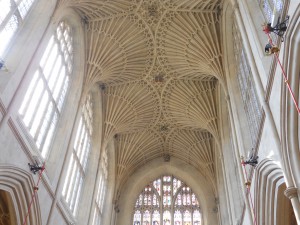
Tags: 2010 Michael · Churches and Cathedrals
September 21st, 2010 · No Comments
For academic purposes I frequented a variety of pubs during my stay in London. In this time I noticed that small decisions made by the management go a long way in determining the atmosphere of a pub. At a favorite of mine, The Rocket, on Thursdays they lower the price of all their shots and have specials on mixed drinks and bottled beer. It was no surprise that on the two Thursdays in which I went to the Rocket we encountered a bunch of young people, in one case a large group of American Freshmen. At another pub I went to, there were no specials and no pitchers. There were, however, a lot of nice beers from around the world and on every table. The clientele, therefore, was mostly older men and was much quieter. I had another varied experience at The Bank of England. The difference in this pub was the high ceilings and grand décor. (Hardly a small decision I realize, but still.) The atmosphere in this pub was definitely classier, and the high ceilings gave off a feeling that, despite the amount of people in the pub, one was never crowded.
One thing I noticed about the pubs was the lack of traditional pub games. I haven’t seen any darts and only been to one pub with pool. Pool was sweet though, despite a crushing defeat that I suffered at the hands of a girl. The only time I’ve ever lost to a girl throughout the entire course of my illustrious life.
Here’s another thought for you. I hate pubs/bars with loud pumping music and no dance floor. What is the point! To make conversation impossible and awkward?
I find Orwell’s remarks on pubs to be quite accurate as well. I find the idea that the perfect pub is impossible to find ties in well with my previous idea about atmosphere. It may be the one coherent thread in this post. For, you see, in my mind, the perfect pub would be both chill and cheap. But these two things are mutually exclusive! Because if the prices are cheap then lots of rowdy people will come and be drunk and order lots of shots and you’ll get that annoying loud atmosphere that completely clashes with the chill one that is ideal. And there you have it folks.
Tags: 2010 Michael · Pubs
September 21st, 2010 · No Comments
I saw five plays in my time here in London, and found the theatre to be one of my favorite aspects of the city. My favorite was Les Miserables, although I sat in the absolute back row and was very far from the stage. The music was tremendous and the acting spectacular. I especially enjoyed the spinning stage, which, although I recall hearing in our theatre tour that it is not altogether uncommon, I had never seen before. 39 steps, while not high theatre, was a lot of fun. The Hitchcock feel of the whole play was really enjoyable and the physical comedy was great. The use of only four actors had me feel like I got to know the actors, not only the characters. This was especially true for the two male actors beside the main character, they were extremely likeable and the four actor format helped foment that. Bedlam was a disastrous play but still a decent experience. From Bedlam I learned that the a bad play is a whole lot more fun than a bad movie, and started me to thinking that plays are a way I would like to spend my evenings. This is despite a complete lack of direction or solid musical numbers and a cast that became almost disinterested by the end of the performance. I also noticed that due to the Globe’s choice of lighting, in which the entire stage is rather evenly lit, the play was at times hard to follow, because it was impossible to know where exactly to look. Merry Wives of Windsor was funny, although I got quite lost at the end of the play unfortunately. After a long day of walking, standing at the theatre was particularly hard for me that day. The Habit of Art was an overall failure in my opinion. It took some excellent themes and fears and excellent acting and buried it in a clumsy and unnecessary frame. We had some genuinely moving scenes between Britain and Alden which could have been drawn out and extrapolated on, but instead we had a lot of little side jokes mainly based on the ‘play in a play’ format.
Overall, the theatre in London has changed my perspective, I’ve realized that a night out with a show is extremely enjoyable. If I had vacation time here I think I would see three to five shows a week. If I lived and worked here I would do the same. It’s very exciting, the theatre scene here and the fact that any night on a limited budget I can go see so many shows, both classics and experimental, new shows.
Tags: 2010 Michael · Theatre
September 21st, 2010 · 1 Comment
Regent’s Park, like all of London, is composed of winding and difficult to follow paths. It contains massive open fields and has a number of soccer pitches and tennis courts. The sports fields immediately set Regent’s apart from St. James and The Green Park. In Green, the main activity was a good sit and St. James has banned sports.
Aesthetically , St. James and Regent’s are also quite different from one another. Regent’s is grand; it seems as though it strives to impress. And, certainly, in my opinion it does not fail. There are manicured gardens with varieties of annual flowers in picturesque arrangements. The gardens are mulched and created with distinct lines. It has expansive views, with long open fields and a good look at the city from Primrose Hill. Fountains and statues with hanging flowers populate the Avenue Gardens and the Queen Mary Garden’s are equally impressive. The gardens will consist of multicolored flowers arranged in intricate patterns.
At St. James the attempt is evidently for a natural look. The flowers, while some are manicured, are more often wildflowers in large patches, with various flowers intermixed in an elegantly effortless manner. The waterfowl and stream provide for a beautiful look and the Pelicans are massive and elegant. I’ve seen pigeons, ducks, geese, swans and pelicans, which make for a lovely array. The view from Blue Bridge down the entire canal and to the surrounding buildings is another great one. St. James also has more randomly placed trees throughout the park.
In the end, I find Regent’s to be more attractive. It has it’s manicured parts, which are nice to walk past and get a look at, but my favorite aspect is the expanse of the park. With so much room it is always possible to find a nook to sit alone, undisturbed.
Tags: 2010 Michael
September 14th, 2010 · 6 Comments
In Fox’s “Watching the English” she examines the English use of the word ‘sorry.’ The final conclusion is that English people will say ‘sorry’ even if you bump directly into them. While she is careful to say that this does not necessarily make the English more polite than other cultures, she fails to examine it from a perspective that I consider very important (because I’m soft and easily offended and also quite sensitive.) I, for one, do not particularly appreciate the ‘sorry’ that one receives when one bumps into a passerby. I feel bad, I usually say something like, “oh, no, it’s fine, my bad.” This sentiment, though, is rather ridiculous, because when I turn to tell them it is not a big deal they are long gone and completely oblivious. This is not what offends me though. It is that when someone runs straight into me, I get the same half-hearted sorry! They didn’t mean sorry in the first example, which is fine, but in the second one they clearly don’t mean it either! So here I am, walking to the tube, I’ve got a backpack, my “London A-Z” out, and some bozo comes flying around the end, nearly sending me sprawling, knocking my aviator shades (which, by the way, were designed in Italy) off my head. And what do I get, as this hurried Londoner rushes by? The same little ‘saw-ree’ that Lawrence Taylor would receive , if he, in a cocaine induced rage, blindsided an elderly woman. In the end, all the Brits should truly be sorry for, is that they’re not sorry.
Tags: 2010 Michael
September 6th, 2010 · 4 Comments
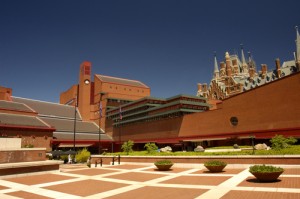
I went to the British Library today to get a library card and begin research. In the two hours I spent there I acutely encountered an English phenomenon that Professor Qualls has described. I suppose I would call it ‘the run around.’ It is a fairly backwards system in which nothing can be accessed directly or simplistically acquired. At every turn this system required another step or was made more complicated or forbade me from receiving normal library benefits. The miserable experience began when I tried to get a library card. I had a passport sized photo and the letter from the University of East Anglia so one would think this process would be simple. And one would be wrong.
First, I had to fill out a list of the books that I would be getting out. Let’s, you and I, reader and myself, take a moment to consider this task. Here I am, setting foot in this library for the first time. I plan on searching through the databases and selection of books to find something worthwhile for research. However, before I have done so, I am obligated to say which books I will be using. While clearly I can just fudge a few names onto the page and say these are the ones I’ll be using, the idea behind the request seems to only serve as an impediment to a process that should be quite simple.
So I fudge the titles, finally get the card after a solid half hour of pure, cool, wasted life and head over to the Humanities section. From there, I’m redirected down to a bag section where I wait in a queue in order to put my backpack in a closet. Why this section was not outside the area I was not allowed into with it remains a mystery. Moving on, I was told that certain books were being kept in Yorkshire and for that reason are only available to be ordered for forty-hours later, which is perfectly understandable. However, when I ordered my books not marked as being kept in Yorkshire, I received a figurative swift kick in the pants. To receive any book from anywhere in the library takes seventy minutes. For effect, I’ll repeat that. Seventy minutes. Yes, that is for any book. Seventy minutes.
Why couldn’t I go up directly to someone working at the Library, ask them where the book was, and retrieve it in, say, 15 minutes? Perhaps because that would be too easy and too simple. Perhaps because the Brits are afraid of direct contact. Or perhaps it is because they take a sick pleasure in watching people go up and down escalators getting progressively more cranky and hungry! But I put that behind me, and said, well, I’ll just wait the seventy minutes and take my requested book out and look at it tonight after dinner, because I was preposterously famished at this point, as I hadn’t anticipated the hundred (70+30) minute process I would encounter before even looking at my first source. At this point, The British Library hit me one final time, delivering a knockout blow. I was informed that you cannot check books out. That’s not a typo nor an exaggeration, folks, you really can’t. I’m not just yankin’ the ol’ chain there. So, in a huff, I left, vowing never to return.
Until tomorrow when my books arrive.
Tags: 2010 Michael
The National Portrait Gallery includes prominent figures in UK history, from great thinkers, philosophers and inventors, to sailors, pirates and conquerors. I only was able to view a small portion of the museum, beginning with the Tudors and ending at the Anti-Slavery Convention of 1840. This painting featured a group of 500 legislators gathered in an assembly hall. The scene depicted was Thomas Clarkson addressing the British and Foreign Anti-Slavery Society, with the hope of abolishing slavery worldwide. The only figure standing is Clarkson, with his arm and forefinger held high and a countenance expressing concern, passion and a certain weariness, emotions symbolic of his lifelong struggle to see the end of slavery in the civilized world. To his left, his wife, Mary, and son, Thomas Jr. anxiously witness the culmination of Clarkson’s work.
In the foreground of the portrait sits Henry Beckford, an emancipated slave and delegate from Jamaica. What is of particular interest to me in this portrait, (besides it’s relevance to the movie ‘Amazing Grace,’ which I thought was pretty sick) is the dignity with which Beckford is treated. One delegate is putting his hand on Beckford’s arm and another, William Allen, gazes directly at him, although Clarkson is the one who is speaking. The respect that the other men in the portrait feel for is readily apparant from their expressions and body language. Beckford is surrounded by Europeans but seemingly treated as an equal, with all parties striving toward the same end.
Also, if one checks the link, there are some inexplicably big ass books at the bottom.
http://www.npg.org.uk/collections/search/largerimage.php?mkey=mw00028&search=ss&firstRun=true&sText=thomas+clarkson&LinkID=mp00903&role=sit&rNo=1
(Courtesy of NPG.org, the official website of the National Portrait Gallery)
Tags: 2010 Michael · Museums · Uncategorized
Leaving the Arran House, we decided to travel the Northern Line from Goodge Street to London Bridge. From there it was a quick walk across the street to Borough Market, which includes Jubilee, Green, and Middle Market. Borough Market can be found tucked behind the Southwark Cathedral.

Before we even fully entered the market, we were hit by a blast of smells. Borough Market is an upscale, artisanal food and foodstuffs market, featuring booths selling everything from specialty fromage, to fresh produce, seafood, wine and beer, and traditional and exotic meats– ostrich! The market was extremely crowded, with people walking through shoulder to shoulder. We were separated from each other at several points due to the shuffling throngs of people.

Due to the high-priced nature of the vendors, the patrons (minus tourists like us) visiting the market appeared to us to be of a higher socioeconomic class. Racially, they were fairly homogenous. Slight variations could be seen from booth to booth, depending on what was being sold. For example, Mikey was passive-aggressively asked to leave a wine booth as he was writing in his notebook, while the booths selling cider tended to cater to the less affluent.
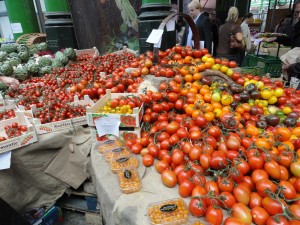
There was almost every sort of food one could hope to find at a market, so in the blog we will just document some of the more surprising or delicious options.
The market as a whole was eco-conscious. Most meats and produce were organic/free-range, and packaging for products was often biodegradable. There were also many interesting and noteworthy foods that were available and that make Borough market worth the trip. At a sausage stand beef, wild boar, venison and ostrich were available (The ostrich, by the way, was delicious.)

At another stand a giant, sliced, puffball mushroom was available. Exotic and expensive fruits such as whole figs and pomegranates were available, and we passed a crepe stand offering fillings of the savory, spicy and sweet variety. Whole fish were for sale, along with squid, scallops and halibut. We were intrigued by a stand vending elderflower cordial, though, as with most of the items of intrigue, it was pushing five quid for even a small drink. At a fine meat stand, there was a sign touting the benefits of the ostrich eggs they were selling- including the rather astounding fact that one ostrich egg is equivalent to twenty chicken eggs- as well as offering a kangaroo burger. We saw duck eggs and whole game mallards, whole hams and various wild boar meats. The upscale beer store was rather astounding as well.
[kml_flashembed movie="http://www.youtube.com/v/BsKDppaXydY" width="425" height="350" wmode="transparent" /]
http://www.youtube.com/watch?v=BsKDppaXydY
If anyone is looking for high-quality specialty foods, the Borough Market is the place. It is lively, expansive, and an a fun experience.
Tags: 2010 Michael · 2010 Rachel · 2010 Sarah

